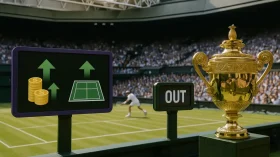The world of professional tennis has evolved significantly since its early days, becoming a global spectacle with its athletes enjoying fame comparable to iconic figures in other major sports. This transformation has been driven by changes in technology, athleticism, and professional opportunities, alongside the rise of some of the sport’s greatest stars.
The Early Years of Tennis
Tennis originated in late 19th-century England as a leisure activity. The first Championships at Wimbledon were held in 1877, and this tournament soon became the cornerstone of the sport’s competitive calendar. For many decades, tennis was dominated by amateur players, as the strict rules of amateurism prevented players from receiving prize money.
The Open Era Begins
The modern era of professional tennis began in 1968 when the Grand Slam tournaments allowed professional players to compete with amateurs, marking the start of the “Open Era.” This was a pivotal moment for tennis, as it led to the growth of a professional tour and the opportunity for players to make a living from the sport. The Open Era also saw the introduction of tiebreaks, colored clothing, and more televised events, which increased the sport’s popularity.
Technological Advancements and Training
The development of tennis racket technology has had a profound impact on the game.
Wooden rackets gave way to metal ones in the 1970s, and later to carbon fiber and other composites, allowing for more power and control.
This technological shift coincided with improvements in physical training and sports medicine, enabling players to hit harder, move faster, and sustain longer careers.
Rise of Global Stars
The allure of tennis has been magnified by its stars, who have become global ambassadors for the sport:
Björn Borg: Known for his cool demeanor and baseline play, Borg was a dominant force in the late 1970s and early 1980s, winning 11 Grand Slam titles before retiring at the age of 26.
Martina Navratilova and Chris Evert: These two dominated women’s tennis in the 1970s and 1980s, their rivalry one of the greatest in tennis history. Navratilova’s athleticism and power contrasted sharply with Evert’s precision and consistency.
Pete Sampras and Andre Agassi: In the 1990s, Sampras and Agassi reinvigorated men’s tennis with their contrasting styles and personalities—Sampras with his powerful serve and volley game and Agassi with his baseline power and charisma.
Serena Williams: Perhaps the most dominant player in modern tennis, Serena has won 23 Grand Slam singles titles, the most by any player in the Open Era. Her powerful playing style and fierce competitiveness have made her a central figure in tennis for over two decades.
Roger Federer, Rafael Nadal, and Novak Djokovic: Often referred to as the “Big Three,” these players have pushed the boundaries of what is possible in tennis. Their rivalry and consistent success across all surfaces have earned them a special place in tennis history.
The Role of Technology and Media
Advancements in broadcast technology have also played a crucial role in the development of professional tennis. High-definition broadcasts and instant replay systems, like the Hawk-Eye, have enhanced the viewing experience and accuracy of the game. Social media has allowed fans unprecedented access to their favorite stars, helping to grow the sport’s audience worldwide.
Economic Growth and Challenges
The economic aspects of tennis have evolved, with increased prize money, lucrative endorsements, and global tournaments contributing to substantial earnings for top players. However, financial disparities remain a challenge, particularly for lower-ranked players who struggle to cover travel and coaching costs.
The development of professional tennis is a story of continual innovation and personality. From changes in equipment and training methods to the influence of charismatic stars and media technology, tennis has transformed into a dynamic, global sport. As it continues to evolve, the allure of its history and the excitement of its future promise to attract fans and players for generations to come.
The history of professional tennis is a rich tapestry woven with significant changes in cultural norms, technological advancements, and the evolving professionalism of the sport.
This narrative spans over a century, showcasing how tennis evolved from a leisure activity for the elite into a globally revered professional sport.
Origins and Early Days
Tennis, as it is known today, originated from a game called “real tennis,” a popular pastime among European monarchs in the Renaissance. The modern game, however, began in 1873 when Major Walter Clopton Wingfield patented a version of the game he called “sphairistike,” which he sold as a boxed set that included all necessary equipment and instructions. This game is widely considered the birth of lawn tennis.
The first Lawn Tennis Championships, now known simply as Wimbledon, were held in 1877 at the All England Club in London, setting the standard for future tournaments. Initially, tennis was strictly amateur, with the French Championships opening to international competitors in 1925, and the U.S. National Championships (now the US Open) following suit.
The Shift to Professionalism
For decades, tennis was dominated by “shamateurism,” where top players were officially amateur but received under-the-table payments. Dissatisfaction with this system led to the emergence of professional tours in the 1920s and 1930s, featuring players who were paid openly for their performances.
In 1968, the sport underwent a revolutionary change with the advent of the Open Era, allowing both amateurs and professionals to compete in Grand Slam tournaments. This era was marked by the first open tournament held at Bournemouth in England, followed by the French Open, which was the first Grand Slam to go open.
Technological Advancements
The development of tennis also features significant technological advancements, particularly in equipment. Rackets evolved from wooden frames to metal and eventually to today’s composite materials like carbon fiber, significantly affecting play style and power. The introduction of metal rackets in the late 1960s and early 1970s, popularized by players like Jimmy Connors, brought more power and spin to the game. This evolution continued with the widespread adoption of synthetic strings that provided even more spin and control.
Growth of the Professional Tour
The establishment of the Association of Tennis Professionals (ATP) in 1972 for men and the Women’s Tennis Association (WTA) in 1973 marked significant milestones in organizing the professional game. These bodies helped structure the professional tours, giving players a greater voice in the sport and leading to the growth of the sport’s global popularity.
Iconic Rivalries and Global Stars
The history of professional tennis is also a history of its stars and rivalries that have captivated audiences worldwide. From the rivalries of Björn Borg and John McEnroe to the Williams sisters, the sport has always been driven by compelling personalities. The intense rivalries and spectacular performances of players like Roger Federer, Rafael Nadal, and Novak Djokovic have elevated the global profile of tennis and set new standards of excellence.
Modern Challenges and Innovations
Today, professional tennis faces new challenges and opportunities. The digital age has transformed how fans engage with the sport, with matches streamed worldwide and players interacting directly with fans via social media. Innovations such as electronic line calling and player challenge systems have improved the accuracy and fairness of the game.
The history of professional tennis reflects broader changes in society regarding technology, professionalism, and global connectivity. From its amateur roots to the high-stakes professional game it is today, tennis has maintained its core of competitive spirit and individual excellence, continually adapting to the changing world. As it moves forward, the sport is poised to remain at the forefront of global athletic culture, appealing to new generations of fans and players alike.
Tennis has become one of the most popular sports globally due to a combination of its unique attributes, cultural significance, and the influence of charismatic stars who have captivated audiences worldwide. Here’s a detailed look at why tennis has achieved such widespread popularity:
Accessibility and Universality
Easy to Learn, Difficult to Master: Tennis is relatively simple to pick up, which makes it accessible to people of all ages and skill levels. Yet, it also offers depth and complexity for those who wish to master it, providing a rewarding challenge for both amateurs and professionals.
Minimal Equipment Required: To start playing tennis, one primarily needs a racket and a few balls. This simplicity allows people to engage with the sport without a significant initial investment, making it accessible to a broader audience.
Playable Year-Round: Tennis can be played both outdoors and indoors, on various surfaces like grass, clay, and hard court. This adaptability makes it a year-round sport, accessible regardless of season or weather.
Impact of Media and Technology
Television and Global Broadcasting: Tennis tournaments are broadcast globally, reaching millions of viewers. Major tournaments like the Grand Slams (Wimbledon, U.S. Open, French Open, and Australian Open) draw large international audiences, boosting the sport’s visibility and popularity.
Advances in Racket Technology: Innovations in racket and string technology have made the game more dynamic and exciting. Players can hit the ball harder and with more spin, making matches more intense and spectator-friendly.
Star Power and Rivalries
Charismatic Champions: The appeal of tennis has been significantly enhanced by charismatic players like Roger Federer, Serena Williams, Rafael Nadal, and Novak Djokovic. These players have not only dominated the sport but have also become global ambassadors for tennis, inspiring new generations of fans and players.
Iconic Rivalries: Rivalries such as Federer vs. Nadal, Evert vs. Navratilova, and Sampras vs. Agassi have captivated fans, creating narratives that extend beyond the sport and into popular culture. These rivalries increase interest in the sport and drive spectator engagement.
Cultural and Social Impact
Tennis as a Social Event: Tennis tournaments, especially the Grand Slams, are often social and cultural events. Events like Wimbledon have traditions that include not just the sport but also aspects of social gathering, such as the famous strawberries and cream.
Global Nature: Tennis is a truly international sport, with major tournaments hosted across different continents and players hailing from numerous countries. This global nature helps maintain high levels of interest in various regions, promoting a sense of global community among fans.
Health and Lifestyle Benefits
Health Benefits: Tennis is excellent for physical health, offering cardiovascular, muscle-strengthening, and coordination benefits. It also has mental health benefits, including improving tactical thinking and providing stress relief.
Lifestyle Sport: Tennis is associated with a healthy, active lifestyle and can be played for a lifetime. It is not uncommon to see players from young children to seniors actively participating in the sport.
Educational and Developmental Aspects
College and Scholarships: Tennis offers numerous opportunities for young players to secure college scholarships in countries like the USA. This potential for educational advancement through sports participation adds another layer of attractiveness to the sport.
Professional Opportunities: Beyond playing, tennis offers career opportunities in coaching, sports management, equipment manufacturing, and media, broadening its appeal to a wider range of participants.
The combination of accessibility, player appeal, media presence, and health benefits has cemented tennis’s status as a popular global sport. Its adaptability to various formats and integration into cultural and social structures further enhance its appeal, making it a favorite among spectators and players alike.
Our friends:
Slottyway opinie
reynaelena.com
sugar rush demo play













